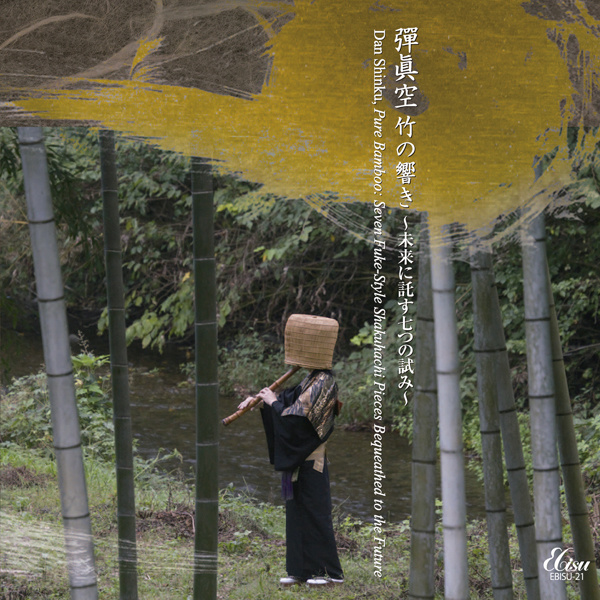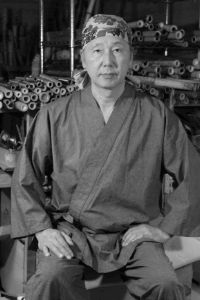■彈眞空 竹の響き
~未来に託す七つの試み~
Dan Shinku, Pure Bamboo:
Seven Fuke-Style Shakuhachi Pieces Bequeathed to the Future
 EBISU-21 税込価格¥3,080(税抜価格¥2,800) 2020/01/07発売 JAN 4530835 112853
EBISU-21 税込価格¥3,080(税抜価格¥2,800) 2020/01/07発売 JAN 4530835 112853
彈眞空(普化宗尺八地無し延べ管)
Dan Shinku (Fuke-style jinashi nobe-kan)
日本経済新聞 ディスクレビュー掲載
 令和2年度(第75回)文化庁芸術祭参加
令和2年度(第75回)文化庁芸術祭参加
[1] 虚空
[2] 大物
[3] 手向
[4] 滝落
[5] 初手
[6] 阿字観
[7] 虚霊
〈録音〉
相模湖交流センター 2019年6月12-13日
近代、大きく変容した楽器の一つに尺八がある。
<自作の竹管に己の魂を吹き込む>
普化宗法器としての竹のあり様をひたすら守り続ける男がここにいる。

彈眞空
1955 東京生まれ。幼少より様々な楽器に親しむ。
1985 高橋空山の比類なき記録『竹の響き』を聴き、その妙音に魅せられ一切の
音楽活動を中止、普化宗尺八に没頭。暗中模索のなか、独学で独自に音色
や旋法の研究、地無し尺八の製管も始める。
1987〜88 ネパール・インドへ尺八行脚敢行。帰国後、空山の高弟・藤由越山に師事。
1991〜94 スペース仙川企画に参加。薩摩琵琶の吉田央舟と語り芝居の佐月梨乃と共
に全国各地で公演。
普化宗尺八「地無し延べ管」と「一節切」の製作講習会を企画・実施。
1996~ 普化宗尺八楽の理念としての原形を求めて、仏教寺院での吹禅開始。
吹・作・創(演奏すること、その楽器を自ら作ること、
温故知新による曲の煉り直しと創作)一体不可分を提唱。
毎秋、竹を求めて東北から九州まで、約3000㎞の旅に出る。
2003 地無し尺八専門の製作工房を開設。普化宗尺八、三節切、一節切、洞簫尺八、
古代尺八(*)等を系統的に研究・製作。
2018 「ワールド尺八フェスティバル2018ロンドン」に招かれ、演奏とレクチャーを行う。
CDは、授記音聲曼陀羅『虚空』(1998)・『鈴慕』(2003)・『霧海篪』(2008)がある。
現在、楽譜の無い音源から作譜する、耳コピの手引書『採譜のすすめ』を執筆中。
◇ ダン・アート企画 / 地無し管工房代表
◇ 虚無僧研究会終身会員
◇ 一般社団法人東洋音楽学会正会員
* 古代尺八(こだいしゃくはち):平安中期まで雅楽で使われていた三節六孔の尺八。
[1]
[2]
[3]
[4]
[5]
[6]
[7]
Recorded on 12-13 June 2019 at Kanagawa Prefectural Lake Sagami-ko Community Center
Dan Shinku
1955: born in Tokyo and began various instruments at a young age.
1985: Heard the incomparable LP recording, Take no Hibiki, by shakuhachi master Takahashi Kūzan. So impressed was he by its appeal that quit all other instruments to concentrate only on the Fuke shakuhachi. He studied mostly on his own and developed various performance and tone-creation techniques. He also began to make jinashi shakuhachi.
1987-88: Travelled on a shakuhachi pilgrimage to Nepal and India. After returning, he began studies with Takahashi Kūzan’s main disciple, Fujiyoshi Etsuzan.
1991-94: Performed at Space Sengawa. Toured Japan together with Satsuma Biwa player Yoshida Ōshū and actress Satsuki Rino, performing theater and storytelling. Began workshops on making jinashi shakuhachi and hitoyogiri.
1996-: Began performing shakuhachi in various temples in order to search for the origins and theory of Fuke shakuhachi music. Realized that performance, instrument making and the discipline of perfecting a piece were inseparable parts of the whole. Every autumn he travels the breadth of Japan (about 3000 kilometers) searching out bamboo for making shakuhachi.
2003: Created a professional studio to research and make jinashi shakuhachi, hitoyogiri (including the miyogiri, an instrument which resembles the three-node gagaku shakuhachi but has five holes instead of six) and the ancient gagaku shakuhachi (the oldest shakuhachi in Japan which was used in the Imperial court gagaku music and dance and had six hole with three nodes) .
2018: Invited to the London World Shakuhachi Festival for lecture and performance.
Dan Shiku CDs include Juki Onsei Mandara Kokū (1998), Reibo, (2003) and Mukaiji (2008). Presently, he is working on transcribing music from recordings and writing a book about the process, entitled Saifu no Susume “(Encouraging Transcription”).
Director of Dan Art Project—The Jinashi Shakuhachi Workshop
Member of the Komusō Research Society
Member of the Society for Research in Asiatic Music.